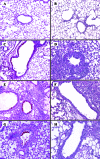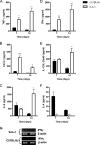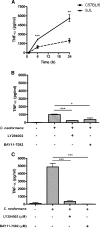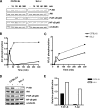Enhanced innate immune responsiveness to pulmonary Cryptococcus neoformans infection is associated with resistance to progressive infection
- PMID: 18678664
- PMCID: PMC2546841
- DOI: 10.1128/IAI.00341-08
Enhanced innate immune responsiveness to pulmonary Cryptococcus neoformans infection is associated with resistance to progressive infection
Abstract
Genetically regulated mechanisms of host defense against Cryptococcus neoformans infection are not well understood. In this study, pulmonary infection with the moderately virulent C. neoformans strain 24067 was used to compare the host resistance phenotype of C57BL/6J with that of inbred mouse strain SJL/J. At 7 days or later after infection, C57BL/6J mice exhibited a significantly greater fungal burden in the lungs than SJL/J mice. Characterization of the pulmonary innate immune response at 3 h after cryptococcal infection revealed that resistant SJL/J mice exhibited significantly higher neutrophilia, with elevated levels of inflammatory cytokine tumor necrosis factor alpha (TNF-alpha) and keratinocyte-derived chemokine (KC)/CXCL1 in the airways, as well as increased whole-lung mRNA expression of chemokines KC/CXCL1, MIP-1alpha/CCL3, MIP-1beta/CCL4, MIP-2/CXCL2, and MCP-1/CCL2 and cytokines interleukin 1beta (IL-1beta) and IL-1Ra. At 7 and 14 days after infection, SJL/J mice maintained significantly higher levels of TNF-alpha and KC/CXCL1 in the airways and exhibited a Th1 response characterized by elevated levels of lung gamma interferon (IFN-gamma) and IL-12/IL-23p40, while C57BL/6J mice exhibited Th2 immunity as defined by eosinophilia and IL-4 production. Alveolar and resident peritoneal macrophages from SJL/J mice also secreted significantly greater amounts of TNF-alpha and KC/CXCL1 following in vitro stimulation with C. neoformans. Intracellular signaling analysis demonstrated that TNF-alpha and KC/CXCL1 production was regulated by NF-kappaB and phosphatidylinositol 3 kinase in both strains; however, SJL/J macrophages exhibited heightened and prolonged activation in response to C. neoformans infection compared to that of C57BL/6J. Taken together, these data demonstrate that an enhanced innate immune response against pulmonary C. neoformans infection in SJL/J mice is associated with natural resistance to progressive infection.
Figures







Similar articles
-
Susceptibility to progressive Cryptococcus neoformans pulmonary infection is regulated by loci on mouse chromosomes 1 and 9.Infect Immun. 2012 Dec;80(12):4167-76. doi: 10.1128/IAI.00417-12. Epub 2012 Sep 17. Infect Immun. 2012. PMID: 22988020 Free PMC article.
-
Th2 but not Th1 immune bias results in altered lung functions in a murine model of pulmonary Cryptococcus neoformans infection.Infect Immun. 2009 Dec;77(12):5389-99. doi: 10.1128/IAI.00809-09. Epub 2009 Sep 14. Infect Immun. 2009. PMID: 19752036 Free PMC article.
-
The role of macrophage inflammatory protein-1 alpha/CCL3 in regulation of T cell-mediated immunity to Cryptococcus neoformans infection.J Immunol. 2000 Dec 1;165(11):6429-36. doi: 10.4049/jimmunol.165.11.6429. J Immunol. 2000. PMID: 11086082
-
Regulation by innate immune T lymphocytes in the host defense against pulmonary infection with Cryptococcus neoformans.Jpn J Infect Dis. 2004 Aug;57(4):137-45. Jpn J Infect Dis. 2004. PMID: 15329444 Review.
-
Paradoxical roles of alveolar macrophages in the host response to Cryptococcus neoformans.J Infect Chemother. 2012 Feb;18(1):1-9. doi: 10.1007/s10156-011-0306-2. Epub 2011 Nov 2. J Infect Chemother. 2012. PMID: 22045161 Free PMC article. Review.
Cited by
-
Kicking sleepers out of bed: Macrophages promote reactivation of dormant Cryptococcus neoformans by extracellular vesicle release and non-lytic exocytosis.PLoS Pathog. 2023 Nov 30;19(11):e1011841. doi: 10.1371/journal.ppat.1011841. eCollection 2023 Nov. PLoS Pathog. 2023. PMID: 38033163 Free PMC article.
-
Pneumocystis elicits a STAT6-dependent, strain-specific innate immune response and airway hyperresponsiveness.Am J Respir Cell Mol Biol. 2012 Mar;46(3):290-8. doi: 10.1165/rcmb.2011-0154OC. Epub 2011 Sep 29. Am J Respir Cell Mol Biol. 2012. PMID: 21960549 Free PMC article.
-
Animal Models of Cryptococcus neoformans in Identifying Immune Parameters Associated With Primary Infection and Reactivation of Latent Infection.Front Immunol. 2020 Sep 15;11:581750. doi: 10.3389/fimmu.2020.581750. eCollection 2020. Front Immunol. 2020. PMID: 33042164 Free PMC article. Review.
-
Role of dendritic cell-pathogen interactions in the immune response to pulmonary cryptococcal infection.Future Microbiol. 2015;10(11):1837-57. doi: 10.2217/fmb.15.92. Future Microbiol. 2015. PMID: 26597428 Free PMC article. Review.
-
Susceptibility to progressive Cryptococcus neoformans pulmonary infection is regulated by loci on mouse chromosomes 1 and 9.Infect Immun. 2012 Dec;80(12):4167-76. doi: 10.1128/IAI.00417-12. Epub 2012 Sep 17. Infect Immun. 2012. PMID: 22988020 Free PMC article.
References
-
- Abadi, J., and L. Pirofski. 1999. Antibodies reactive with the cryptococcal capsular polysaccharide glucuronoxylomannan are present in sera from children with and without human immunodeficiency virus infection. J. Infect. Dis. 180915-919. - PubMed
-
- Arora, S., Y. Hernandez, J. R. Erb-Downward, R. A. McDonald, G. B. Toews, and G. B. Huffnagle. 2005. Role of IFN-gamma in regulating T2 immunity and the development of alternatively activated macrophages during allergic bronchopulmonary mycosis. J. Immunol. 1746346-6356. - PubMed
-
- Biondo, C., A. Midiri, L. Messina, F. Tomasello, G. Garufi, M. R. Catania, M. Bombaci, C. Beninati, G. Teti, and G. Mancuso. 2005. MyD88 and TLR2, but not TLR4, are required for host defense against Cryptococcus neoformans. Eur. J. Immunol. 35870-878. - PubMed
Publication types
MeSH terms
Substances
LinkOut - more resources
Full Text Sources
Molecular Biology Databases
Miscellaneous

